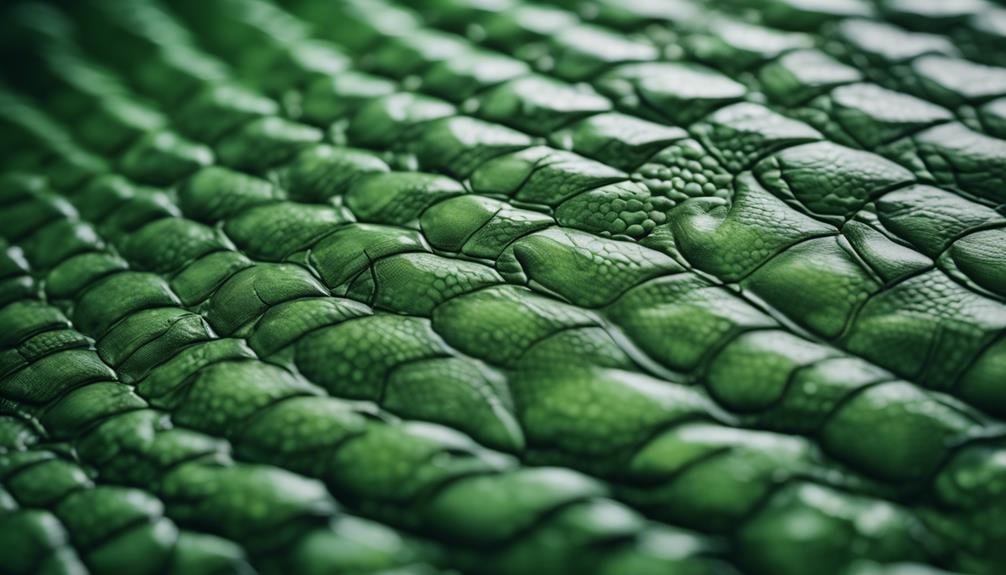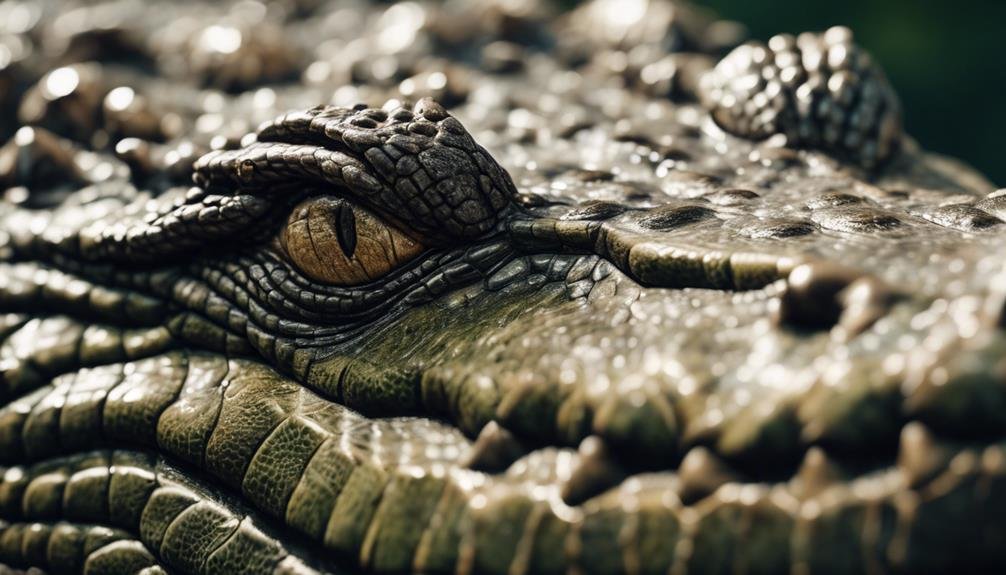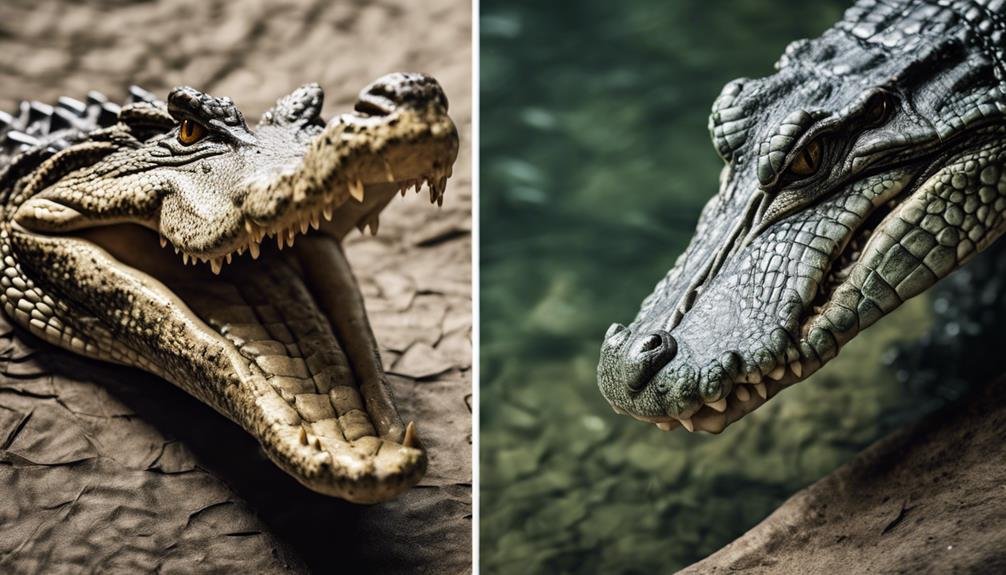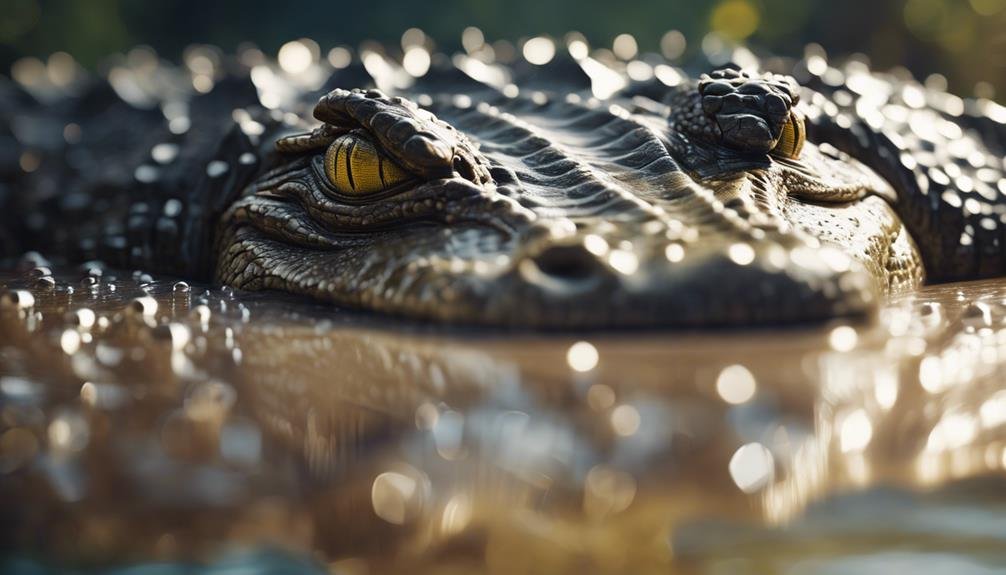You might think you know crocodiles, with their fearsome jaws and powerful tails, but there's more to their scaly appearance than meets the eye. Indeed, crocodiles do have scales, but these aren't just any scales. They're a vital system essential for survival, from regulating body temperature to aiding in movement. Yet, many misconceptions float around about their impenetrable nature and what they're truly made of. As we peel back the layers on these keratin-rich structures, you'll discover their intricate role in a crocodile's life and how they distinguish crocodiles from their reptilian relatives. Prepare to be surprised by what lies beneath the surface.
Key Takeaways
- Crocodiles have scales made of keratin, aiding in protection, movement, and thermoregulation.
- Their scales are sensitive and crucial for survival, not an impenetrable armor.
- Shedding and regrowing scales is a regular process for skin health and sensory maintenance.
- Scales vary in texture: bumpy for heat absorption and smooth for efficient movement.
- Misconceptions exist about scales being unyielding shields, whereas they are essential for ecological adaptations and survival.
Crocodile Scale Basics
At first glance, crocodile scales might seem just for show, but they're actually soft, sensitive, and essential for the reptile's survival. Unlike the hard, impenetrable armor one might expect, the scales of crocodiles are more akin to human skin in their sensitivity. This unique characteristic allows them to interact with their environment in ways that are important for their wellbeing. Their skin, covered in these bumpy scales, plays a pivotal role beyond mere protection.
The scales act as mini solar panels, a fascinating aspect of crocodile biology. By absorbing heat from the sun, these scales enable crocodiles to regulate their body temperature. This process of heat absorption is crucial for these cold-blooded creatures, as it helps them maintain the necessary body warmth for digestion and overall health. The smooth scales found on their bellies further aid in their ability to navigate through muddy waters with ease, showcasing the scales' multifunctionality.
Moreover, the unique texture of crocodile scales enhances their ability to manage body temperature effectively. This feature is particularly important for an animal that spends significant time both in the water and basking in the sun. The scales' design and placement across the crocodile's body are no accident; they're a proof of the evolutionary adaptation that has enabled these ancient reptiles to thrive in diverse environments.
Scale Functionality and Uses
Delving into the functionality and uses of crocodile scales, it's clear they're not just for defense; they also play an essential role in the reptile's ability to thrive in its habitat. These scales, made of keratin and reinforced with bony plates, provide crocodiles with a rugged armor for protection against predators. Additionally, they're important for regulating body temperature.
Crocodile scales serve multiple purposes, from absorbing heat to aiding in movement. Here's a quick look:
| Scale Location | Function | Benefit |
|---|---|---|
| Back | Heat absorption | Helps in thermoregulation |
| Belly | Smooth movement | Efficient in water and mud |
| Overall | Protection | Shields from predators |
| Underwater | Temperature maintenance | Stays warm while submerged |
| Skin | Tactile sensitivity | Enhances environmental interaction |
The bumpy scales on their backs, resembling mini solar panels, soak up the sun's warmth, while the smooth scales underneath ensure they glide seamlessly through their aquatic and muddy environments. This unique combination of scales, rich in keratin, not only armors them but also finely tunes their body temperature, keeping them agile and responsive in their diverse habitats.
Keratin Composition Explained


Crocodile scales, composed of tough keratin similar to what's found in your hair and nails, vary considerably in thickness and structure to suit their survival needs. This keratin provides essential protection, helping crocodiles thrive in their environments, from murky riverbeds to rocky shores. Here's how this material plays an important role in their survival:
- Protection Against Predators: Keratin makes the scales incredibly tough, offering a formidable barrier against attacks from predators and rivals.
- Injury Prevention: The density and composition of keratin in the scales minimize injuries crocodiles might encounter while moving through rough terrains.
- Adaptability: The variation in thickness and structure of keratin across different body parts allows crocodiles to adjust to various environmental conditions.
- Unique Defense Mechanism: Unlike the scales of lizards and snakes, the keratin composition in crocodile scales provides a unique combination of flexibility and defense, enabling them to move freely and protect themselves.
Keratin, hence, isn't just a component of crocodile scales; it's an essential element in their survival, offering protection and adaptability in the wild.
Scale Texture and Appearance
Exploring the texture and appearance of crocodile scales reveals a fascinating aspect of their biology, where bumpy and smooth scales serve important purposes. Crocodile skin is a marvel of nature, designed with precision to fit their lifestyle. The bumpy scales on their backs aren't just for show; they're like mini solar panels. These scales absorb heat, helping crocodiles regulate their body temperature with surprising efficiency. Contrary to what you might think, these bumpy scales are soft and sensitive, not hard. They provide protection while still allowing crocodiles to sense their environment.
On the flip side, the belly of a crocodile showcases smooth scales. These scales play an essential role in their ability to move through mud smoothly and efficiently. The contrast between the bumpy and smooth scales isn't just a matter of texture but a demonstration of the adaptability and functionality of crocodile skin. The scale texture of crocodiles is unlike lizard scales, feeling more akin to a human hand than a rough surface. This unique combination of bumpy and smooth scales equips crocodiles with the versatility needed to thrive in their aquatic environments.
Scale Growth and Shedding


Like clockwork, a crocodile's scales shed and grow regularly, guaranteeing their skin remains healthy and functional. This process is essential for their survival, not just a mere biological curiosity. Here's how it happens and why it's so important:
- Protection through Keratin: The scales, made of keratin, serve as a formidable shield against predators and environmental hazards.
- Periodic Shedding: Over time, scales undergo shedding, allowing crocodiles to remove old and damaged layers of skin. This isn't a one-off event but a constant cycle that ensures their outer protection remains intact.
- Growth of New Scales: Fresh, new scales replace the old ones, maintaining the strength and durability of their skin. This cycle of growth and shedding keeps their defenses robust.
- Sensory Function Maintenance: Shedding and regrowth are essential for preserving their sensory functions. Fresh scales mean better sensitivity to their surroundings, important for hunting and exploring their environment.
Thermoregulation Role
You've learned how crocodiles' unique scales assist in thermoregulation, but let's explore further how they use the environment to their advantage.
Through sun basking behavior, they harness the sun's warmth, while their water cooling method allows them to maintain an ideal body temperature.
This dual approach is essential for their survival in varying climates.
Sun Basking Behavior
Crocodiles bask in the sun to regulate their body temperature, utilizing bumpy scales on their backs as mini solar panels. This sun basking behavior is essential for their survival, as it helps maintain their body heat. Here's how they do it:
- Bumpy Scales Absorb Heat: The bumpy scales on their backs catch and hold sunlight, warming the crocodiles efficiently.
- Thermoregulation: By adjusting their position in relation to the sun, crocodiles can increase or decrease their body temperature.
- Blood Flow Adjustment: Crocodiles can move blood to their scales to either warm up or cool down.
- Efficient Warming: These bumpy scales make sun basking an effective way to gain warmth, especially after cold nights or while emerging from cool waters.
Water Cooling Method
While basking in the sun helps crocodiles warm up, they also rely on water cooling methods to lower their body temperature when it gets too high. This is where their unique scale structure plays a pivotal role in thermoregulation.
The bumpy scales, acting like mini solar panels, aren't just for heat absorption but also facilitate efficient cooling. These bony plates are strategically designed to release excess heat when the crocodile submerges in water.
The smooth scales on their bellies, contrasting with the bumpy ones on their backs, make sure they can glide through the water with ease, further aiding in the cooling process.
This intricate system allows crocodiles to maintain their body temperature effectively, showcasing the critical role of scale structure in their survival.
Crocodile Vs. Alligator Scales


How do the scales of crocodiles and alligators differ, and what impact does this have on their respective abilities to thrive in their environments? When you look closely, the differences in their scales play a significant role in how they adapt and survive in their habitats.
Here are key points to take into account:
- Bumpy Scales for Heating: Crocodiles have bumpy scales on their backs, which act like mini solar panels. These scales are adept at absorbing heat, which is vital for regulating their body temperature.
- Smoother Scales for Stealth: Alligators, on the other hand, sport smoother scales, especially on their backs. This smoother texture is less adept at heat absorption but might aid in a more stealthy movement through water.
- Temperature Regulation: The bumpy scales on crocodiles not only absorb heat but also help in temperature regulation by moving blood into them, an essential aspect for their survival in various climates.
- Movement Efficiency: Crocodiles have smooth belly scales, which facilitate easier movement through mud and water, indicating an evolutionary design for efficiency in their natural habitats.
Understanding the distinct differences between crocodiles and alligators, particularly their scales, sheds light on their unique adaptations and survival strategies.
Debunking Scale Myths
You might think you know what crocodile scales are all about, but there's more to them than meets the eye.
Misunderstandings about their scale structure have led to some widely held but incorrect beliefs.
Let's clear up these misconceptions and get a true understanding of crocodile scales.
Scale Structure Explained
Unraveling the truth about crocodile scales reveals a world of misconceptions and demonstrates their unique structure and function. You mightn't know that crocodiles are closely related to birds, which influences their scale structure. Unlike the hard, impenetrable surface many imagine, their scales are a marvel of nature designed for survival in harsh environments.
- Closely Related to Birds: Shares evolutionary traits affecting skin and scale development.
- Salt Glands: Embedded in their thick-skinned jaws, helping in osmoregulation.
- Thick Skinned: Protects against predators and environmental hazards, not just from their sharp teeth.
- Sensitive Scales: Contrary to popular belief, their scales are soft and sensitive, akin to the sensitivity of human skin, allowing for environmental interaction.
This precise structure supports their survival, from regulating body temperature to aiding in camouflage.
Common Scale Misunderstandings
Despite common beliefs, crocodile scales aren't the essential armor many assume but are in fact soft, sensitive, and vital for their survival. This misconception often extends to comparing them with alligators, assuming both species boast identical defenses.
However, it's the unique bumpy scales of crocodiles that enable them to effectively regulate their body temperature. These scales aren't just for show; they function almost like solar panels, absorbing heat and allowing crocodiles to warm up by directing blood flow to these areas.
Contrary to the myth of their scales forming an unyielding shield, they're surprisingly soft and play a significant role in their ecological adaptations, helping these remarkable reptiles navigate their aquatic environments and maintain their body temperature, especially while submerged or moving through mud and water.
Are Crocodile Scales Related to Their Amazing Eyesight?
Yes, crocodiles’ impressive night vision and their scales are related. The specialized cells in their eyes, called rods and cones, work in tandem with the unique arrangement of their scales to enhance their visual perception in low light conditions. This combination gives them a distinct advantage when hunting at night.
Frequently Asked Questions
Do Crocodiles Have Scales?
Yes, crocodiles do have scales. Their scales aren't just for show; they're vital for protection, thermal regulation, and environmental adaptation. These scales come in various patterns and color variations, helping crocs camouflage and thrive in their habitats.
As they grow, their scale patterns and sizes change, reflecting their age and growth dynamics. The bumpy scales on their backs and smoother scales on their bellies enhance their ability to navigate through water and mud.
What Is an Unknown Fact About Crocodiles?
You mightn't know that crocodiles can't actually cry 'crocodile tears' when they're feeling emotional. This phrase comes from a myth!
Their ancient lineage dates back millions of years, showing their incredible adaptability.
Another fascinating fact is their temperature dependence; they rely on the environment to regulate their body temperature.
Plus, their jaw strength is unmatched, making them one of the most powerful predators in their habitat.
What Are Some Disturbing Facts About Crocodiles?
You might find it disturbing that crocodile attacks aren't uncommon. These ambush predators, with their powerful jaws, have an ancient lineage that's perfected the art of surprise.
They're known for their aggression, attacking humans, pets, and livestock alike. Their behavior stems from territorial disputes and their natural predatory instincts.
It's a grim reminder of their status as one of the most formidable predators in their ecosystems.
Why Are Crocodiles Scaly?
You might wonder why crocodiles are scaly.
Well, their scales play an important role in skin durability, helping them resist harsh conditions.
These scales aren't just for show; they're essential for water dynamics, allowing crocs to move smoothly through their aquatic environments.
Plus, the bumpy texture gives them a predatory advantage, camouflaging them among riverbeds.
Most importantly, their scales are key for thermal regulation, absorbing sunlight to keep them warm.
Conclusion
To conclude, crocodiles do have scales, which are far more than just essential armor. They're made of keratin, aiding in movement, temperature regulation, and adapting to various environments. Unlike the myths suggest, these scales are sensitive and vital for a crocodile's survival.
They differ in texture and function from alligator scales, debunking common misconceptions. So, next time you think of crocodile scales, remember they're not just for defense—they're key to the crocodile's thriving life.


